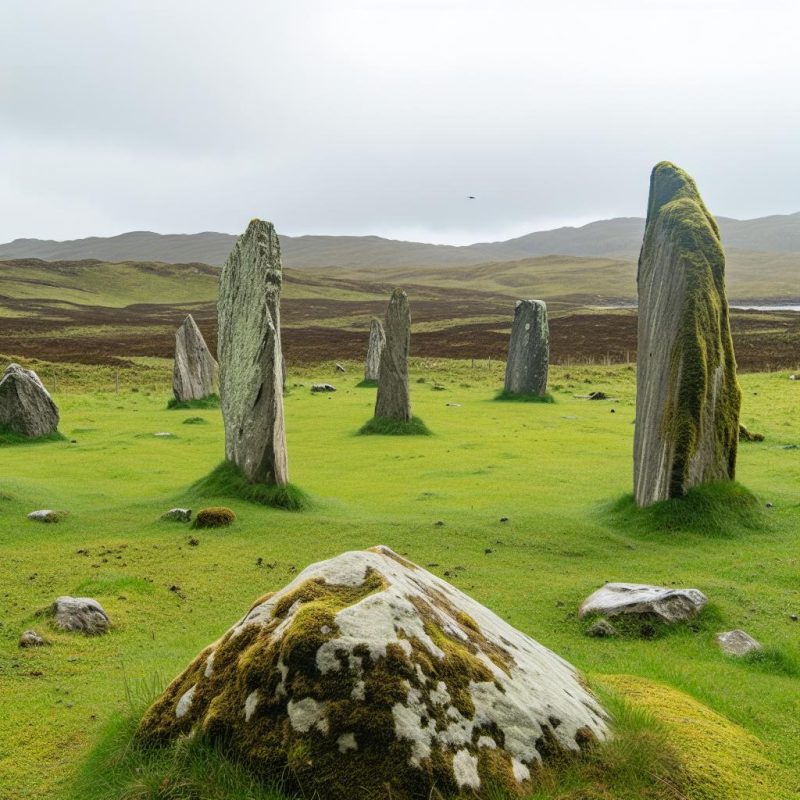Exploring the Standing Stones and Cairns of Argyll
Argyll, located on the picturesque west coast of Scotland, harbors a fascinating concentration of ancient standing stones and cairns. These remarkable megalithic structures offer a unique glimpse into the mystical and historical aspects of early Scottish civilization. They provide invaluable insights into the rituals, communal practices, and knowledge of the people who lived during those times.
The Kilmartin Glen: A Treasury of Prehistoric Sites
Among the many awe-inspiring regions in Argyll, Kilmartin Glen stands out as a treasure trove of prehistoric sites. Spread across a six-mile radius, this area boasts over 800 ancient monuments, making it a vital center for understanding Scotland’s ancient cultures. Central to this region are the Temple Wood Stone Circles, which consist of intricate rings believed to have been used for both ceremonial and astronomical purposes.
Adjacent to these circles, Nether Largie hosts a series of prehistoric chambered burial cairns, dating back to the Neolithic era. This series of cairns is aligned with standing stones nearby, which likely played a pivotal role in ancient practices related to celestial events. The careful alignment of these sites reflects the sophistication and astronomical expertise of ancient communities in Argyll.
The Significance of Standing Stones
Standing stones, frequently termed menhirs, are upright stones whose functions span a wide range of applications, from marking celestial occurrences to delineating territorial boundaries. In regions like The Ballymeanoch Standing Stones within the Glen, the strategic arrangement and directionality of the stones imply a calendrical or astronomical function. These stones provide key insights into the community planning and the sophisticated astronomical understanding prevalent at the time.
In addition to standing stones, Dunchraigaig Cairn represents a significant architectural feat, believed to serve as a burial site. The care in its placement and the techniques used in its construction highlight the advanced engineering skills possessed by those ancient societies, as well as their cultural values.
Engagement with the Landscape
The strategic placement of these ancient structures within the landscape underscores their importance as centers of both social and spiritual activities. Many of these sites were intentionally located to exploit the natural interplay between land and sea, highlighting their role in understanding ancient belief systems. The concentration of cairns and stone circles within particular geographical landscapes suggests their significant roles in demarcating territories and establishing sacred spaces.
The interaction with the landscape where these monuments reside further denotes a deep understanding of the environment by ancient inhabitants. It was not merely about erecting structures; it was about integrating them with the natural world in meaningful ways. This symbiotic relationship with the land informs a broader narrative about the cultural and spiritual life of the communities.
Preserving Argyll’s Megalithic Heritage
Preserving these ancient sites is vital for maintaining the historical narrative of Scotland’s prehistoric heritage. Many of these significant locations are protected by national heritage regulations, ensuring their protection for future generations. Ongoing conservation efforts are crucial to maintain their integrity and continue offering educational opportunities for both locals and visitors. Institutions like the Kilmartin Museum are instrumental in these efforts, providing valuable insights and resources to deepen the understanding of these treasures.
Visitors who are keen on delving into Scotland’s rich and ancient history will find Argyll a compelling destination. The standing stones and cairns do more than mark history; they serve as critical touchstones that illuminate the astronomical and cultural heritage of Scotland. These monuments allow modern observers to connect with the lives and practices of ancestors, offering a profound educational experience. Engaging with Argyll’s heritage is not simply about viewing historical artifacts; it is an inviting journey into the past that enhances understanding of our shared human history.

